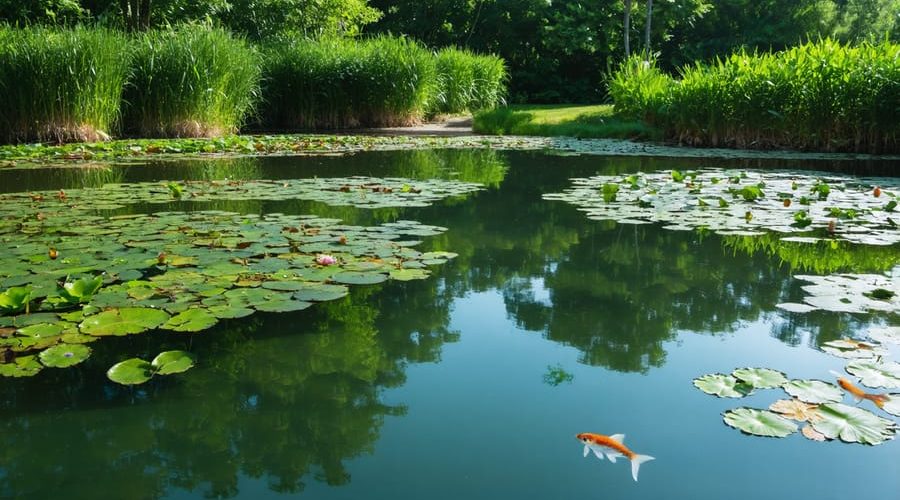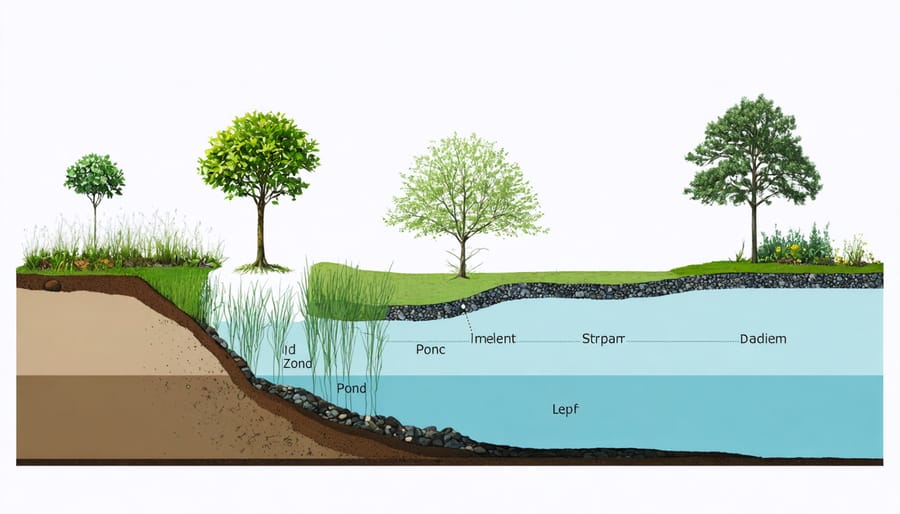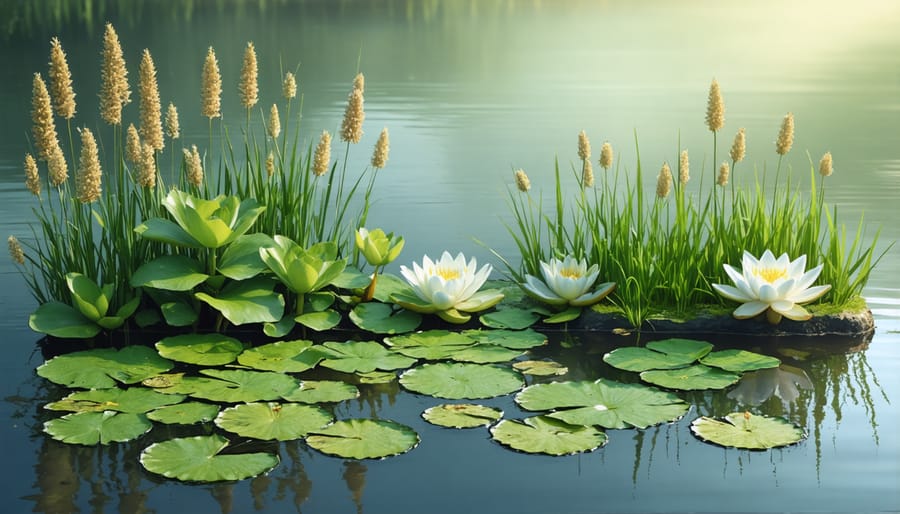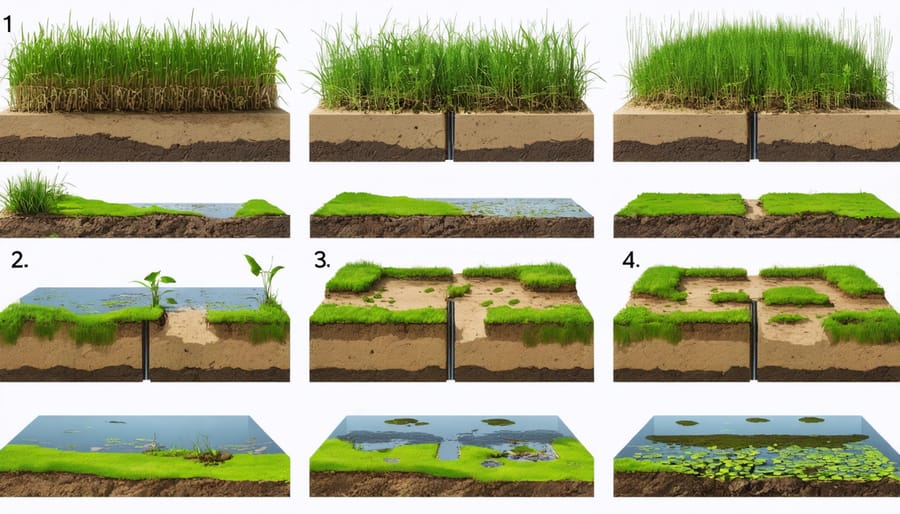
Clean, Clear Pond Water: Natural Filtration That Actually Works
Transform your pond into a self-sustaining ecosystem through the power of natural filtration benefits. Create a biological filtering zone by planting water lilies, cattails, and rushes along the pond’s edge, allowing their roots to absorb excess nutrients and trap debris. Layer the pond bottom with beneficial bacteria-rich gravel and clay, establishing a natural foundation that breaks down organic waste and maintains crystal-clear water. Position submerged plants like hornwort and anacharis strategically throughout the pond, as these aquatic workhorses oxygenate the water while filtering out harmful compounds. Add a balanced mix of surface-floating plants to provide shade, reduce algae growth, and complete your pond’s natural filtering system. This holistic approach mimics nature’s own purification methods, creating a thriving aquatic environment that practically maintains itself.
Understanding Natural Pond Filtration
The Three Zones of Natural Filtration
Natural pond filtration works through three distinct zones, each playing a crucial role in maintaining aquatic ecosystem balance. Think of these zones as nature’s very own filtration system, working together like a well-orchestrated team!
The shallow zone, typically 6-12 inches deep, is where most of the biological filtering magic happens. This area hosts marginal plants like rushes and irises, whose roots act like tiny filters, trapping debris and absorbing excess nutrients. It’s also home to beneficial bacteria that break down waste materials.
Moving into the middle zone (1-2 feet deep), you’ll find submerged plants like water lilies. These plants are particularly good at controlling algae by limiting sunlight penetration and competing for nutrients. They also provide shelter for beneficial microorganisms that help purify the water.
The deep zone, usually 2-4 feet deep, acts as a natural settling area where solid particles sink to the bottom. This zone maintains stable water temperatures and provides a safe haven for fish during extreme weather. The cooler temperatures at this depth also help reduce algae growth and maintain healthy oxygen levels.
By incorporating all three zones in your pond design, you create a self-sustaining system that naturally maintains clean, clear water with minimal intervention.


Essential Plants for Natural Filtration
Submerged Oxygenating Plants
Submerged oxygenating plants are the unsung heroes of natural pond filtration, working tirelessly beneath the surface to keep your water crystal clear. These underwater plants absorb excess nutrients, release oxygen, and help prevent algae growth, making them essential for a healthy pond ecosystem.
Some of the most effective oxygenating plants include Hornwort, which grows in dense clusters and provides excellent filtration, and Elodea (also known as waterweed), which thrives in various water conditions. Water Milfoil is another fantastic choice, known for its feathery leaves that trap debris while adding dissolved oxygen to the water.
For best results, plant these underwater helpers in weighted bunches or pots filled with aquatic soil. Aim to cover about 50-60% of your pond’s bottom with oxygenating plants. They’ll not only help filter your water but also provide shelter for beneficial microorganisms and small aquatic creatures.
Remember to trim these plants occasionally to prevent overcrowding, especially during summer months when growth is most vigorous. The trimmed portions can be composted, returning nutrients to your garden in a different way.
Floating Plants
Floating plants are nature’s own water purifiers, creating a beautiful and functional layer on your pond’s surface. These plants work tirelessly to absorb excess nutrients, particularly nitrates and phosphates, that would otherwise feed unwanted algae. Popular options like water lilies, water hyacinth, and duckweed spread their roots directly into the water, creating natural filters while providing shade that helps maintain cooler water temperatures.
For best results, aim to cover about 50-70% of your pond’s surface with floating plants. Water hyacinth is particularly effective, with each plant capable of absorbing significant amounts of nutrients through its extensive root system. Duckweed, though tiny, multiplies quickly and is excellent at removing excess nutrients, making it perfect for smaller ponds.
Besides their filtering abilities, floating plants offer valuable shelter for fish and create natural hiding spots from predators. They also help reduce water evaporation and provide lovely blooms throughout the season. Just remember to thin out fast-growing species like duckweed regularly to maintain the right balance in your pond ecosystem.
Marginal Plants
Marginal plants are nature’s perfect pond filters, growing along the edges where they create a vital transition zone between water and land. These plants work tirelessly to absorb excess nutrients, particularly nitrogen and phosphates, which helps prevent algae growth. Popular choices include iris, rushes, and cattails, which develop extensive root systems that trap debris and provide a home for beneficial bacteria.
For the best filtering effect, plant these marginals in shallow shelves around your pond’s edge, about 2-6 inches below the water surface. Marsh marigolds add bright splashes of yellow while filtering water, and sweet flag grass not only cleanses but also releases a pleasant aroma. Water forget-me-nots create beautiful blue carpets while helping to maintain water quality.
These plants also provide essential cover for wildlife like frogs and newts, which help maintain the pond’s ecological balance. For maximum effectiveness, aim to cover about 50-60% of your pond’s edge with marginal plants, spacing them about 12 inches apart to allow for growth. Remember to trim them back in late autumn to prevent excess organic matter from falling into the water.
Creating a Natural Bog Filter
A bog filter is one of the most effective ways to build a natural pond filter that mimics nature’s own cleaning process. Here’s how to create your own:
Start by selecting a location near your pond, ideally slightly elevated to allow gravity-fed water flow. You’ll need to dig a separate area about 20-30% the size of your pond, with a depth of around 2 feet. Line this area with pond liner, ensuring there are no leaks.
Fill the bottom 6 inches with large gravel (1-2 inches in diameter), followed by a middle layer of medium-sized gravel. Top it off with a layer of small gravel or pea gravel. This creates different levels of filtration as water moves through the system.
Install a submersible pump in your pond connected to PVC piping that leads to the bog filter. The pipe should extend across the bottom of the bog, with small holes drilled every few inches to distribute water evenly.
Now comes the fun part – planting! Choose a variety of marginal plants like rushes, iris, and cattails. These plants’ roots will grow through the gravel, creating an incredibly effective biological filter. Space them about 6-8 inches apart to allow for growth.
Water from your pond will be pumped through the gravel layers, where beneficial bacteria colonize and break down waste. The plants absorb excess nutrients, effectively removing them from the water system. The cleaned water then flows back into your pond.
For best results, let your bog filter establish for a few weeks before expecting perfect results. Regular maintenance is minimal – just trim plants as needed and occasionally clean any debris from the surface. Your bog filter will become more efficient over time as the plant roots develop and bacterial colonies establish themselves.

Beneficial Bacteria and Microorganisms
Beneficial bacteria are the unsung heroes of natural pond filtration, working tirelessly to break down waste and maintain crystal-clear water. These microscopic workers convert harmful ammonia from fish waste and decaying matter into less harmful nitrates that plants can use as nutrients. When combined with proper pond aeration, these bacteria thrive and multiply, creating a self-sustaining ecosystem.
You’ll find these helpful microorganisms naturally colonizing your pond’s surfaces – rocks, gravel, plant roots, and even the pond liner itself. To give them a boost, consider adding porous materials like lava rock or bio-balls to your pond, creating more surface area for bacterial colonies to establish themselves. Some gardeners also use starter cultures to kickstart the bacterial population, especially in new ponds.
Remember, patience is key when establishing beneficial bacteria. It typically takes 4-6 weeks for a healthy colony to develop. During this time, avoid using chemical treatments that might harm these beneficial microorganisms, and maintain consistent water conditions to help them flourish.
Maintenance Tips for Natural Filtration
Keeping your natural pond filtration system in top shape doesn’t have to be complicated. Regular maintenance is key to ensuring your pond stays crystal clear and healthy. Start by checking your plants monthly during the growing season – trim away any dead or yellowing leaves before they can decay in the water. This simple task prevents excess nutrients from building up.
For bog gardens and plant filters, gently rake through the substrate every few months to prevent compaction. This helps maintain good water flow and keeps beneficial bacteria happy. In spring and fall, divide and replant any overgrown aquatic plants to maintain their filtering efficiency.
Monitor your water level weekly and top it up when needed, especially during hot weather. Use rainwater when possible, as it’s gentler on your pond’s ecosystem. Keep an eye on your pond’s edges and remove any debris that could fall in and decompose.
Once a year, usually in early spring, perform a gentle clean-out of your biological filter areas. Remove about one-third of the old substrate and replace it with fresh material. This maintains filtering capacity without disturbing the established beneficial bacteria too much.
Remember to observe your pond regularly – changes in water clarity or unusual odors can signal maintenance needs. Quick action on small issues prevents bigger problems down the line, keeping your natural filtration system working effectively year-round.
Natural pond filtration offers a sustainable, beautiful, and effective way to maintain crystal-clear water while supporting a thriving ecosystem. By combining various methods like beneficial plants, beneficial bacteria, and proper fish stocking, you can create a self-maintaining system that requires minimal intervention. Remember that patience is key – natural filtration systems take time to establish but provide long-lasting results. The investment in natural filtering methods not only benefits your pond’s health but also contributes to local biodiversity and reduces your environmental impact. Start small, observe your pond’s unique needs, and gradually expand your natural filtration system. With proper maintenance and care, your naturally filtered pond will become a stunning focal point in your outdoor space while providing a healthy habitat for fish, plants, and wildlife.
